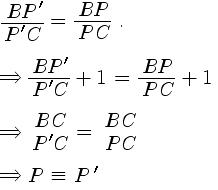

-Ceva's Theorem-
Consider any triangle ABC. Select a point P inside the triangle and draw lines AP, BP, and CP extended to their intersections with the opposite sides in points D, E, and F respectively.
Observe the following file. Drag points A, B, C, and P and explore (AF)(BD)(EC) and (FB)(DC)(EA).
What can you find?
If you want its GSP file, Click HERE!
As you can see, (AF)(BD)(EC) is always the same as (FB)(DC)(EA); that is,
![]() .
.
Now, I will prove this. However, we should prove the following theorem before our conjecture, which is called the 'Menelaus Theorem.'
<Theorem>
For any triangle ABC, three points P, Q, and R on extended lines BC, CA, AB respectively lie on the same line if and only if
![]() .
.
<proof>
( =>)
Like above figure, suppose P, Q, and R lie on the same line and let p, q, and r is the lengths of perpendicular line from each vertex A, B, and C, respectively. Then, by the feature of similar triangles,

( <= ) Suppose
![]() holds.
holds.
If the line passing through points P and Q meet BC at the point P', since R, Q, and P' lie on the same line,
![]() .
.
Divide this equation by
![]() .
Then,
.
Then,

Therefore, points R, Q, and P lie on the same line.
Now, prove Ceva's theorem.
For any triangle ABC, lines AD, BE, and CF connecting each point A, B, and C and D, E, and F on each side BC, CA, and AB, respectively meet at a point P if and only if the following equation holds;
![]() .
.
<Proof>
( => ) Suppose that three lines AD, BE, and CF meet at a point P. Then, by previous theorem,
![]() .
.
Multiply two equations, then
![]()
( <= ) Suppose
![]() and a line BE meets a line AD at a point P
and a line segment CP meets side AB at a point F '. Then, three line segments
AD, BE, and CF meet at a point P, so
and a line BE meets a line AD at a point P
and a line segment CP meets side AB at a point F '. Then, three line segments
AD, BE, and CF meet at a point P, so
![]() .
.
Divide this equation by
![]() .
Then,
.
Then,
![]() .
.
Therefore, F = F ' .
Generally, Ceva's Theorem is true when a point P is outside triangle ABC.
Explore below file. Drag the points A, B, C, and P.
If you want GSP file, Click HERE!
Return to Main Page